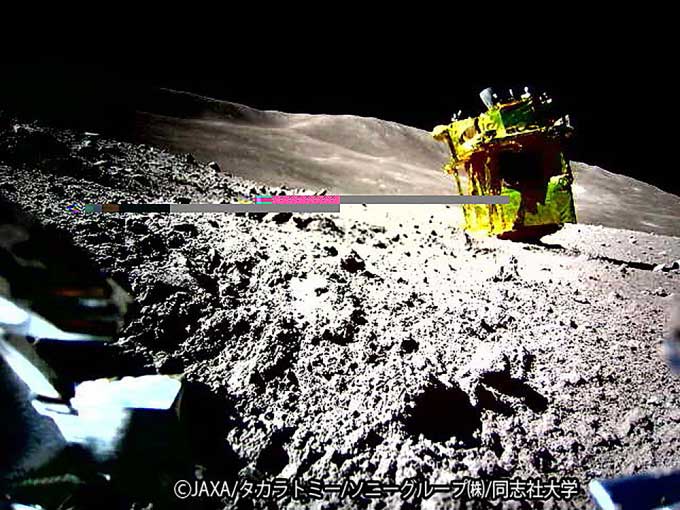The SLIM lander successfully achieved its objective of landing accurately on the Moon and transmitting data back to Earth, despite encountering a solar panel issue that prevented it from generating power and required a pause in operations a few hours post-landing.
Today, the Japan Aerospace Exploration Agency (JAXA) announced that the Smart Lander for Investigating Moon (SLIM) landed just about 55 meters from its designated target and released the first color images from the mission.
SLIM, nicknamed the Moon Sniper due to its high precision, was tasked with landing within 100 meters of its target, a significantly tighter range than the usual several kilometers.

The yellow SLIM lander on the Moon’s surface. (Image: JAXA/Takara Tomy/Sony Group/Doshisha University/AFP)
“SLIM has successfully landed softly and accurately. The landing point has been confirmed to be just 55 meters from the target,” JAXA stated. The lander faced some engine issues during the descent, which may have caused it to veer off course, according to Shinichiro Sakai, the SLIM project manager. Previously, the spacecraft was on track to land even closer to the designated point.
SLIM landed successfully on the Moon at 10:20 PM on January 19 (Hanoi time), making Japan the fifth country to accomplish a soft landing on Earth’s natural satellite, following the United States, the Soviet Union, China, and India. However, the spacecraft faced a setback post-landing: The solar panels ceased to generate power.
JAXA decided to disconnect SLIM’s power supply shortly before 1 AM on January 20, when approximately 12% of its energy remained, to prevent future complications with reactivation. Remote sensing data indicated that SLIM’s solar panels were facing west. If sunlight strikes the Moon from the west in the future, JAXA believes there is a chance for the panels to generate power, and the lander could resume operations. Before shutting down the lander remotely, the mission control station received imaging and technical data from the landing and the lunar surface.
“Based on current estimates, we are preparing for the resumption of lander operations around February 1,” JAXA said.
Two small robots that SLIM carried were also successfully deployed. One robot is equipped with a transmitter, while the other is designed to move around the lunar surface and send images back to Earth. This mini autonomous robot, named SORA-Q, is slightly larger than a tennis ball and can change its shape.
Among the images recently released by JAXA, one taken by SORA-Q clearly shows the condition of SLIM. The yellow lander remains intact and is slightly tilted on the rocky gray surface, with the Moon’s slopes visible in the distance.
The SLIM mission aims for a depression believed to contain a deeper layer of the Moon’s crust, which is typically hidden beneath the surface. By analyzing rocks in that area, JAXA hopes to shed light on the mysteries of potential water resources on the Moon. This is a key factor for establishing bases on the celestial body.


















































